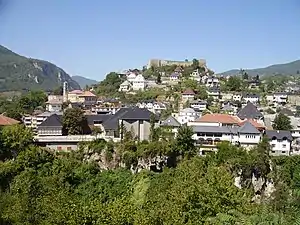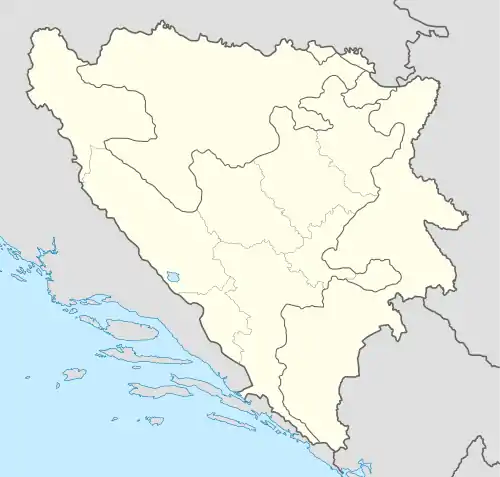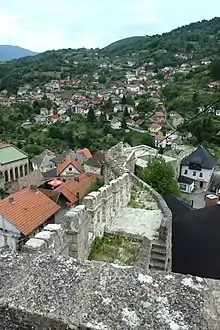Walled city of Jajce
The Walled City of Jajce (Bosnian, Croatian and Serbian: Jajačka tvrđava / Јајачка тврђава) is a medieval fortified nucleus of Jajce in Bosnia and Herzegovina, with citadel high above town on top of pyramidal-shaped steep hill, enclosed with approximately 1,300 metres (4,300 ft) long defensive walls,. It is one of the best preserved fortified capitals of the Bosnian Kingdom, the last stronghold before the kingdom dissolved under the pressure of military advancement at the onset of Ottoman Empire takeover.
| Walled city of Jajce | |
|---|---|
| Jajce, Bosnia and Herzegovina | |
 Jajce Fortress in August 2007 | |
 Walled city of Jajce | |
| Coordinates | 44.340°N 17.269°E |
| Site history | |
| Built | 14th century |
| Built by | Hrvoje Vukčić Hrvatinić |
| Events | In 1461 coronation of the last Bosnian king, Stephen Tomašević of Bosnia; In 1463 and 1527 captured by the Ottomans; In 1471 captured by Matthias Corvinus |
| Garrison information | |
| Past commanders | Matthias Corvinus, Petar Berislavić, Tvrtko II of Bosnia, Stephen Thomas of Bosnia, Stephen Tomašević of Bosnia, Hrvoje Vukčić Hrvatinić |
Geography
The fortress was built on the top of a hill, surrounded by a small settlement on the eastern slopes, at the end of the 13th and beginning of the 14th century. It was repaired, rebuilt and enlarged many times since, until it encompassed the entire settlement underneath with its large walls. The fortress became a citadel which covers an area of 11,200 square metres (121,000 sq ft). The combined length of the walls is 1,300 metres (4,300 ft). The whole area is geographically and historically interesting.[1]
History

The fortress was built by Hrvoje Vukčić Hrvatinić, the founder of Jajce. However, the city became the seat of the Bosnian kings, hence the royal coat of arms decoration on the citadel entrance. A part of the wall was built by the Hungarian King, while the Ottomans erected the powder magazine. The walls are high and the castle was built on a hill that is egg shaped, the rivers Pliva and Vrbas also protect the castle. There is no rampart on the south and west.[2]
Jajce was first built in the 14th century and served as the capital of the independent Kingdom of Bosnia during its time. The town has gates as fortifications, as well as a castle with walls which lead to the various gates around the town. About 10–20 kilometres from Jajce lies the Komotin Castle and town area which is older but smaller than Jajce. It is believed the town of Jajce was previously Komotin but was moved after the Black Death.
The first reference to the name of Jajce in written sources is from the year 1396, but the fortress had already existed by then. Jajce was the residence of the last Bosnian king Stjepan Tomasevic; the Ottomans besieged the town and executed him, but held it only for six months, before the Hungarian King Matthias Corvinus seized it at the siege of Jajce and established the Banovina of Jajce.[3]:36
Skenderbeg Mihajlović besieged Jajce in 1501, but without success because he was defeated by Ivaniš Korvin assisted by Zrinski, Frankopan, Karlović and Cubor.
During this period, Queen Catherine restored the Saint Mary's Church in Jajce, today the oldest church in town. Eventually, in 1527, Jajce became the last Bosnian town to fall to Ottoman rule.[4] The town then lost its strategic importance, as the border moved further north and west.
Jajce passed with the rest of Bosnia and Herzegovina under the administration of Austria-Hungary in 1878. The Franciscan monastery of Saint Luke was completed in 1885.
National monument

The Walled city of Jajce is located at the confluence of the Pliva and Vrbas rivers. It was founded and started developing in the Middle Ages and acquired its final form during the Ottoman period. There are several churches and mosques built in different times during different rules, making Jajce a rather diverse town in this aspect. It is declared National Monument of Bosnia and Herzegovina, and, as the old Jajce city core, including the waterfall, and other individual sites outside the walled city perimeter, such as the Jajce Mithraeum, it is designated as The natural and architectural ensemble of Jajce and proposed as such for inscription into the UNESCO's World Heritage site list. The bid for inscription is currently placed on the UNESCO Tentative list.[5][6]
Gallery
 Jajce fortress
Jajce fortress Bastion of Jajce fortress
Bastion of Jajce fortress Jajce fortress, southwest entrance with the royal Kotromanić coat of arms
Jajce fortress, southwest entrance with the royal Kotromanić coat of arms
See also
| Wikimedia Commons has media related to Walled city of Jajce. |
References
- http://www.turizam-bosna.com/index.php?option=com_content&task=view&id=20&Itemid=126
- Dr. Ćiro Truhelka Kraljevski grad Jajce
- The wider benefits of investment in cultural heritage: Case studies in Bosnia and Herzegovina and Serbia. Council of Europe, 2015
- Pinson, Mark (1996) [1993]. The Muslims of Bosnia-Herzegovina, the Historic Development from Middle Ages to the Dissolution of Yugoslavia (Second ed.). United States of America: President and Fellows of Harvard College. p. 11. ISBN 0-932885-12-8. Retrieved 6 May 2012.
[...] in Bosnia Jajce under Hungarian garrison actually held until 1527
- "The natural and architectural ensemble of Jajce – UNESCO World Heritage Centre". UNESCO World Heritage Centre. Archived from the original on 10 January 2018. Retrieved 25 December 2017.
- "UNESCO World Heritage Centre – Tentative Lists: Bosnia and Herzegovina". UNESCO World Heritage Centre. Archived from the original on 16 July 2017. Retrieved 25 July 2017.
